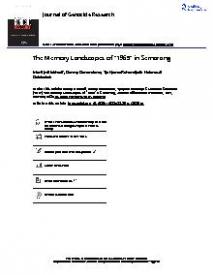The Memory Landscapes of “1965” in Semarang
This article focuses on the formation of memory in relation to the mass violence of the years 1965/68 in Semarang. This port city offers a unique opportunity for studying both the violence of 1965/68 and its long-term effects from a local to a global level. Once nicknamed the “red city” and famous for its Chinese community, the events of “1965” deeply affected the city. Many (alleged) communists from Semarang were sent to prison camps in other parts of Indonesia, while many members of the Chinese community sought refuge abroad. As a result, the mass violence in Semarang continues to reverberate not only in the city, but also throughout and beyond Indonesia.
The article is based on the results of two workshops in Semarang, during which a group of Indonesian students studied the memory landscapes of “1965” by combining oral history with site observations. The central question is how the memory of violence, shaped primarily by everyday interaction and communication, relates on the one hand to the urban space in which the violence largely took place, and on the other hand to the official state narratives that deliberately created memory gaps regarding this violence.
We focus on three sites representative of different aspects of the mass violence of the years 1965/68 in Semarang: the Sarekat Islam building, the Mangkang mass grave and the Chinese Karang Turi school. Scrutinizing these three sites has taught us that people in Semarang make sense of “1965” through stories and activities that, while interacting with the official narratives, include the missing and the dead. Communism might have been “crushed” with success, but the Indonesian state clearly failed to eradicate the memory of state-supported anti-communist violence.
In: Journal of Genocide Research, ISSN 1462-3528 ; eISSN 1469-9494 | 19 | 4 | 530–550
https://doi.org/10.1080/14623528.2017.1393945


